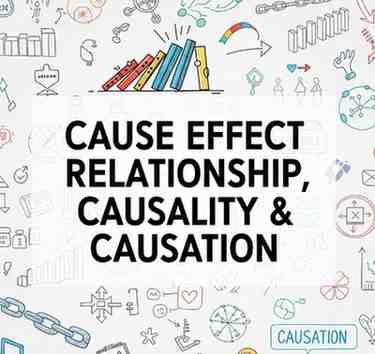
Your Account
Designed by Zeptt Technologies

The concept of cause and effect (Karya-Karana Siddhanta) forms the basis of diagnosis and treatment in both Ayurveda and modern science.
Understanding causality helps in disease prevention, prognosis, and planning rational therapeutic approaches.
In Padartha Vijnana, the analysis of cause-effect relationship is described under Karana, Karya, Karya-Karana Bhava, and Karya-Karana Virodha.
Contemporary sciences like epidemiology, pathology, and research methodology have developed various models to define and test causality.
DEFINITION OF KARANA AND KARYA IN AYURVEDA
Karana is the cause or the factor responsible for the production of an effect.
Karya is the result or effect produced from the interaction of causes.
REFERENCE IN CLASSICAL TEXTS
“Karya karanabhavashcha nityo nityatvameva cha l Karyabhave na karanam karanabhave na karyam l”
— Vaisheshika Darshana
(The existence of cause and effect is interdependent. Without the cause, effect does not occur, and without the effect, the cause is not recognized.)
TYPES OF KARANA (CAUSES) ACCORDING TO VAISHESHIKA
Samavayi Karana – Inseparable cause (e.g., threads in cloth)
Asamavayi Karana – Indirect cause (e.g., color of thread causing color of cloth)
Nimitta Karana – Efficient cause (e.g., weaver making the cloth)
CAUSE-EFFECT RELATIONSHIP IN AYURVEDA
Nidana Panchaka is the clinical model of cause-effect relationship in Ayurveda, involving:
Hetu (cause)
Purvarupa (prodromal features)
Rupa (symptoms)
Upashaya (palliative tests)
Samprapti (pathogenesis)
“Hetu linga aushadhanam trividham karma lakshanam l”
— Charaka Samhita, Sutrasthana 11/23
(Cause, symptom, and medicine form the triad of clinical understanding of disease and its management.)
PRINCIPLES OF CAUSALITY IN CONTEMPORARY SCIENCE
In modern sciences, causality is determined by several methods such as:
Temporality: Cause must precede the effect
Association: Observed link between variables
Dose-response relationship: Higher exposure leads to higher effect
Biological plausibility: Mechanistic explanation
Experimental evidence: Reproducibility in trials
HILL’S CRITERIA OF CAUSALITY (MODERN MEDICINE)
Developed by Sir Austin Bradford Hill to assess causal relationships in epidemiological studies:
Strength of association
Consistency
Specificity
Temporality
Biological gradient
Plausibility
Coherence
Experiment
Analogy
MODERN EXAMPLES IN MEDICAL SCIENCE
Smoking → Lung cancer: Strong dose-response, biological plausibility
Helicobacter pylori → Peptic ulcer: Demonstrated by Koch’s postulates and clinical response to antibiotics
Streptococcus pyogenes → Rheumatic fever: Time-bound immune mechanism supports causation
CAUSALITY IN RESEARCH AND STATISTICS
Controlled experiments (e.g., Randomized Controlled Trials) are the gold standard for establishing causation.
Observational studies (cohort, case-control) identify association and generate hypotheses about causality.
Bias and confounding factors must be considered in interpreting cause-effect relationships.
SANKHYA PHILOSOPHY AND SATKARYAVADA
Ayurveda adopts Satkaryavada from Sankhya Darshana, stating that effect pre-exists in cause in subtle form.
“Asat akaranat upadana grahanat sarvasambhavabhavat shaktasya shakyat karanat karya karanabhavat cha sat karya”
— Sankhya Karika 9
(Effect cannot emerge from non-existence; it must exist in cause as potential.)
KARYA-KARANA VYATIREKA IN DIAGNOSTICS
Vyatireka Nyaya is applied in clinical diagnosis: If cause is absent, effect is also absent.
E.g., Absence of viral infection means no viral fever; no dosha vitiation means no disease formation.
IMPORTANCE OF CAUSALITY IN AYURVEDIC CHIKITSA
Correct identification of Hetu leads to Hetuvyapashraya Chikitsa – removal of causative factor.
Yukti or rationality in treatment is based on proper understanding of Samprapti (pathogenesis).
Preventive medicine (Swasthavritta) focuses on removing or avoiding known Nidana.
COMPARATIVE UNDERSTANDING – AYURVEDA VS MODERN SCIENCE
| Aspect | Ayurveda | Modern Science |
|---|---|---|
| Model | Karya-Karana Siddhanta | Epidemiological & Experimental Studies |
| Basis | Darshana & Samhitas | Observation, Hypothesis, Experimentation |
| Approach | Qualitative, Holistic | Quantitative, Analytical |
| Proof | Yukti, Anumana, Pratyaksha | Statistical Significance, Causal Inference |
CLINICAL IMPLICATIONS
Accurate understanding of causality prevents misdiagnosis.
Enhances formulation of Samprapti Vighatana (breaking pathogenesis) in Ayurveda.
In modern science, enables development of targeted therapies and preventive protocols.